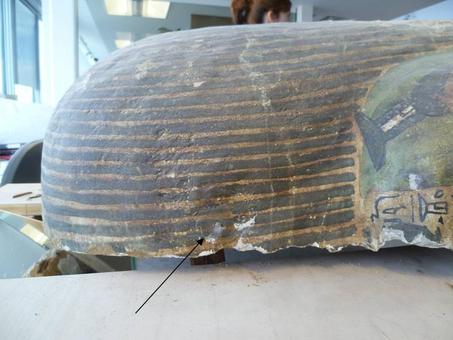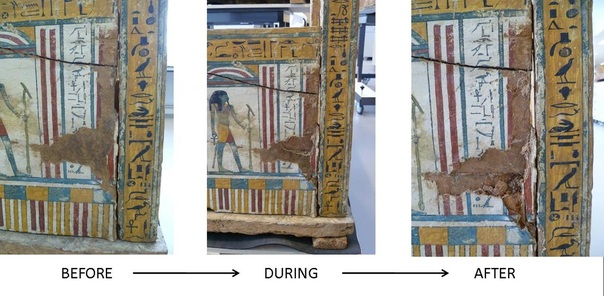In the 1960s a filler was developed in the UCL conservation department as an alternative to plaster, that was used into the 1990s to treat a wide variety of materials. Applications included the reconstruction of ceramics, filling wooden objects, adhering and reinforcing fossils, and repairing musical instruments. This filler was called AJK dough, and was made by kneading together Alvar (polyvinyl acetate), jute flock and kaolin powder with a solvent. Butvar (polyvinyl butyral) was used from 1980, when Alvar ceased to be manufactured, creating a very similar material called BJK.
Recipe for AJK dough
The adhesive used makes the filler very strong and because it is a thermoplastic, the dough can be manipulated by the application of heat. There can be a significant amount of shrinkage as the solvent evaporates, so the filler was often applied in thin layers or allowed to pre-shrink (as in the method below).
During the 1970s AJK was often use to fill large gaps in archaeological ceramics. The following procedure was used:
For some applications the appearance of the AJK, brown and fibrous, was advantageous because it blended in well with the object. This is the case for many fossils. In other instances the appearance was disfiguring and the AJK was painted, with varying success.
Recipe for AJK dough
- Take 100 parts by weight of Alvar 770 (or Butvar B98)
- Stir resin into a solvent mix of 120 p.b.w. of acetone, 50 of IMS & 40 of amyl acetate
- Leave for 24 hours for the resin to dissolve
- Add 100 p.b.w. of xylene & 60 of water
- Stir well until emulsified
- Using a wooden spoon, stir in jute flock and dry kaolin (2:1) until the mixture is too stiff to stir
- Turn out onto a large tray and knead in more of the dry ingredients until the mixture is no longer sticky (good kneading is essential)
- Store in a wide necked bottle or roll into slabs for future use
The adhesive used makes the filler very strong and because it is a thermoplastic, the dough can be manipulated by the application of heat. There can be a significant amount of shrinkage as the solvent evaporates, so the filler was often applied in thin layers or allowed to pre-shrink (as in the method below).
During the 1970s AJK was often use to fill large gaps in archaeological ceramics. The following procedure was used:
- Roll out dough to 1/16 – 1/8 inch thick (a few mm)
- Sheet marked into strips (0.5cm-1cm wide), scoring the lines with a spatula or whatever (score don’t cut)
- Left to harden - preshrink
- Strips snapped apart like Kitkat
- Warmed on hotplate to shape – against vessel or using template
- Retain shape on cooling, inserted to span gaps in network. Attach using adhesive e.g. cellulose nitrate
- Soft dough added to gaps. If to be thicker than ¼ inch (0.6cm) build up in layers
- Smooth with spatula dipped in IMS but be careful to prevent warping of framework
- Because of shrinkage on drying, it will usually be necessary to correct the curvature of reconstructed areas with a final application of dough once the main part of the work is dry.
- Finish with sandpaper (& paint)
- For smooth surfaced vessels can finish with a layer of plaster crack-filling compound eg Alabastine, or with a synthetic resin gap-filler e.g. Bondafiller
For some applications the appearance of the AJK, brown and fibrous, was advantageous because it blended in well with the object. This is the case for many fossils. In other instances the appearance was disfiguring and the AJK was painted, with varying success.
Treatment of an ancient Egyptian coffin
In 2011 I treated an ancient Egyptian coffin belonging to Djeddjehutyefankh (Djed) in the Ashmolean Museum. It had previously been liberally filled with AJK, which was now considered to be disfiguring. Some areas of AJK were removed, which revealed the original object beneath.
On other parts of the coffin AJK had been used to fill cracks caused by the original manufacture using multiple pieces of wood. When humidity changes, wood absorbs or desorbs water and changes shape slightly, as does the gesso used to decorate it. The AJK does not absorb water so does not change shape like the wood. Along the cracks the AJK had held the edges too strongly when the wood had moved, and had caused the gesso to crack and separate. In these areas the AJK had to be removed to free the gesso, which could then be re-adhered to the wood in its original position.
A third situation occurred where the AJK had been used to fill large gaps in the sides of the coffin. Here the AJK was removed, for fear of damage to the gesso and/or wood, and the holes filled with a more appropriate moisture sensitive material (Klucel G and paper pulp).
In yet other areas, the AJK had caused such severe damage to the gesso that removal of the AJK would have put the decoration at risk. In these places the AJK was left in place but covered in spider tissue that was painted to blend in with the decoration.
In yet other areas, the AJK had caused such severe damage to the gesso that removal of the AJK would have put the decoration at risk. In these places the AJK was left in place but covered in spider tissue that was painted to blend in with the decoration.
Use of AJK on geological specimens
AJK / BJK dough has been extensively applied to fossils and other geological specimens as a filler and a bulky adhesive because the colour blends in well and the dough is very strong which holds the heavy pieces.Used on:
• fossil and sub-fossil bone (Larkin & Makridou 1999)
• deteriorating shaley-coal blocks (Howie 1979, 277)
• bones in a clay matrix (Kermack et al. 1973)
• in a grid on unsupported areas eg skulls (Cornwall 1974)
• built up around metal rods/wires to fill long shafts (Rixon 1976, 30)
AJK dough is non-aqueous and so recommended for use on pyritic fossils (Howie 1979, 276).
• fossil and sub-fossil bone (Larkin & Makridou 1999)
• deteriorating shaley-coal blocks (Howie 1979, 277)
• bones in a clay matrix (Kermack et al. 1973)
• in a grid on unsupported areas eg skulls (Cornwall 1974)
• built up around metal rods/wires to fill long shafts (Rixon 1976, 30)
AJK dough is non-aqueous and so recommended for use on pyritic fossils (Howie 1979, 276).
This research is also published in The Journal of the Institute of Conservation 37 (2014) as "The diverse use of AJK dough in conservation"
DOI: 10.1080/19455224.2013.873726
DOI: 10.1080/19455224.2013.873726
References
Carreck, J.N., and Adams, S.J., 1969. Field extraction and laboratory preparation of fossil bones and teeth, using expanded polyurethane. Proceedings of the Geologists' Association 80(1), 81-89 .
Gedye, I., 1968. Pottery and Glass. In: The Conservation of Cultural Property. Paris: UNESCO, 109-113.
Gedye, I., Hodges, H., and Oddy, A., 1973. Notes for a short course on conservation. From notes supplied by the various lecturers. © The British Museum Research Laboratory. Unpublished lecture notes from the Institute of Archaeology, UCL.
Grattan, D.W., and Barclay, R.L., 1988. A study of gap-fillers for wooden objects. Studies in Conservation 33(2), 71-86.
Horie, C.V., 1987. Materials for conservation: organic consolidants, adhesives and coatings. London: Butterworths.
Howie, F.M.P., 1979. Technical: Physical conservation of fossils in existing collections. The Geological Curator 1979, Vol. 2(5), 269-280.
Kermack, K.A., Mussett, F.L.S., and Rigney, H.W., 1973. The lower jaw of Morganucodon. Zoological Journal of the Linnean Society 53(2), 87-175.
Koob, S., 1998. Obsolete fill materials found on ceramics. Journal of the American Institute for Conservation 37(1), 49-67.
Lane, H., 1974. The restoration of thin metal vessels using glass-fibre and polyester resin. Studies in Conservation 19(4), 227-232.
Larkin, N.R., and Makridou, E., 1999. Comparing gap-fillers used in conserving sub-fossil material. The Geological Curator 1999, Vol. 7(2), 81-90.
Larney, J., 1971. Ceramic restoration in the Victoria and Albert Museum. Studies in Conservation 16(2), 69-82.
Newman, B.H., 1955. The use of Fibrenyle. Museums Journal 55.
Organ, R.M., 1961. The consolidation of fragile metal objects. Studies in Conservation, 6(4), Abstracts of the Rome Conference, 135-136.
Patterson, C., 1978. Conservation of ethnographical musical instruments. The Conservator 2, 45-48.
Plenderleith, H.J., and Werner, A.E.A., 1971. The conservation of antiquities and works of art: treatment, repair and restoration. 2nd ed.. London: Oxford University Press.
Rixon, A.E., 1976. Fossil animal remains: their preparation and conservation. London: Athlone Press: distributed by Humanities Press.
Williams, N., 1992. The Sutton Hoo Helmet. In: A. Oddy (ed.) The art of the conservator. London: Published for the Trustees of the British Museum by British Museum Press, 73-88.
Gedye, I., 1968. Pottery and Glass. In: The Conservation of Cultural Property. Paris: UNESCO, 109-113.
Gedye, I., Hodges, H., and Oddy, A., 1973. Notes for a short course on conservation. From notes supplied by the various lecturers. © The British Museum Research Laboratory. Unpublished lecture notes from the Institute of Archaeology, UCL.
Grattan, D.W., and Barclay, R.L., 1988. A study of gap-fillers for wooden objects. Studies in Conservation 33(2), 71-86.
Horie, C.V., 1987. Materials for conservation: organic consolidants, adhesives and coatings. London: Butterworths.
Howie, F.M.P., 1979. Technical: Physical conservation of fossils in existing collections. The Geological Curator 1979, Vol. 2(5), 269-280.
Kermack, K.A., Mussett, F.L.S., and Rigney, H.W., 1973. The lower jaw of Morganucodon. Zoological Journal of the Linnean Society 53(2), 87-175.
Koob, S., 1998. Obsolete fill materials found on ceramics. Journal of the American Institute for Conservation 37(1), 49-67.
Lane, H., 1974. The restoration of thin metal vessels using glass-fibre and polyester resin. Studies in Conservation 19(4), 227-232.
Larkin, N.R., and Makridou, E., 1999. Comparing gap-fillers used in conserving sub-fossil material. The Geological Curator 1999, Vol. 7(2), 81-90.
Larney, J., 1971. Ceramic restoration in the Victoria and Albert Museum. Studies in Conservation 16(2), 69-82.
Newman, B.H., 1955. The use of Fibrenyle. Museums Journal 55.
Organ, R.M., 1961. The consolidation of fragile metal objects. Studies in Conservation, 6(4), Abstracts of the Rome Conference, 135-136.
Patterson, C., 1978. Conservation of ethnographical musical instruments. The Conservator 2, 45-48.
Plenderleith, H.J., and Werner, A.E.A., 1971. The conservation of antiquities and works of art: treatment, repair and restoration. 2nd ed.. London: Oxford University Press.
Rixon, A.E., 1976. Fossil animal remains: their preparation and conservation. London: Athlone Press: distributed by Humanities Press.
Williams, N., 1992. The Sutton Hoo Helmet. In: A. Oddy (ed.) The art of the conservator. London: Published for the Trustees of the British Museum by British Museum Press, 73-88.



